How Do You Teach Patients That Can Not Read or Write
This PowerPoint presentation includes thirty slides, with speaker's notes, that tin be delivered in 30-45 minutes to a group or equally a self-study program.
Slide Presentation
Slide 1. Hidden Barriers and Practical Strategies
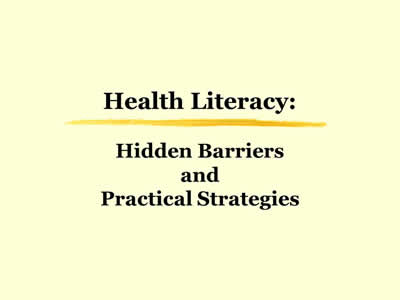
Speaker'southward Notes:
This presentation is on the topic of wellness literacy. The purpose of having this word is to understand what health literacy is and how information technology affects our patients. We will likewise touch some practical strategies that can help our exercise practice a better job caring for people with low wellness literacy.
Slide 2. Hidden Barriers to Communicating with Patients

Clients/Patients
- Education/Literacy/Linguistic communication.
Health Literacy: The capacity to:
- Obtain, process, understand basic wellness information and services.
- Make appropriate health care decisions (deed on information).
- Access/navigate wellness care organization.
Speaker's Notes:
Our clients or patients come up to usa with various levels of education or literacy, and they may prefer to speak a different language, and these issues can become barriers for them to empathise health information. As researchers realized this was an issue, they began to talk about health literacy which is defined as the capacity to:
Obtain, procedure and understand basic health information and services.
And to brand appropriate health care decisions or human activity on wellness information.
And lastly the ability to access or navigate the health intendance system, which we all know is extremely complicated.
Any client who does not read or write well, has problem communicating or agreement exact communications about health, speaks a dissimilar language, or has problem agreement or using numbers could take trouble with these areas.
Slide iii. Using a Health Literacy Universal Precautions Approach
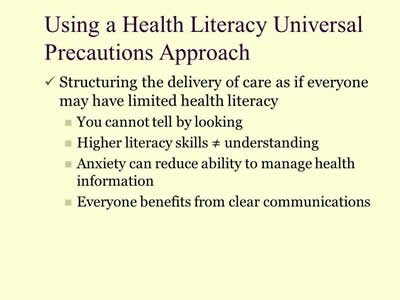
- Structuring the commitment of intendance equally if anybody may have express health literacy:
- Yous cannot tell past looking.
- Higher literacy skills ≠ understanding.
- Anxiety can reduce ability to manage health information.
- Everyone benefits from clear communications.
Speaker's Notes:
You lot cannot tell someone'southward literacy level merely by looking at them. A person may nowadays themselves well, speak well, and appear to understand what is going on, still this does non mean that they truly do.
It is best to approach care with the agreement that even those who are well educated may withal struggle with health-related information. The language used in the health field is not commonly used in everyday language and fifty-fifty those with skilful educational backgrounds may not understand what their diagnosis means or what is existence asked of them.
Even someone who normally manages health data well may have increased difficulty under certain circumstances. When a person is feeling anxious, or overwhelmed with too much information, they may non be able to empathise or utilise health information every bit well every bit normal. [Tell a personal wellness literacy story about when you had trouble understanding health information.]
At the stop of the day, it is best to use simple, clear language to avoid any opportunity for misunderstanding.
Slide four. National Assessment of Adult Literacy
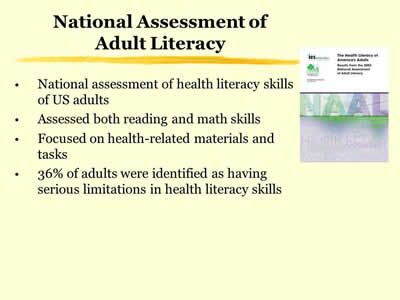
- National assessment of wellness literacy skills of Usa adults.
- Assessed both reading and math skills.
- Focused on health-related materials and tasks.
- 36% of adults were identified as having serious limitations in health literacy skills.
Paradigm: The front cover a publication titled "The Health Literacy of America's Adults: Results From the 2003 National Cess of Adult Literacy".
Speaker's Notes:
In 2003, the United states Department of Instruction conducted the get-go national cess of health literacy skills in the Us.
The assessment was called the National Assessment of Adult Literacy and it measured people'southward ability to read health-related data and manage numerical information related to health.
In this very big, randomized sample of adults anile 16 and over, more than one/3 of participants were identified as having health literacy skills considered inadequate for managing the demands of the current healthcare system.
Slide v. IOM Written report on Wellness Literacy
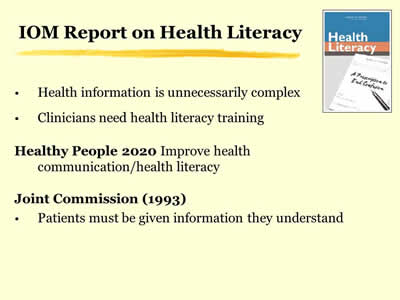
- Health information is unnecessarily complex.
- Clinicians demand wellness literacy training.
Healthy People 2020 Amend health advice/health literacy.
Joint Committee (1993)
- Patients must exist given information they understand.
Image: The front cover a publication titled "Health Literacy: A Prescription to Finish Confusion".
Speaker's Notes:
In 2004, the Institute of Medicine issued a report on health literacy chosen "A Prescription to End Defoliation." That study describes that 90 million adults have trouble understanding and acting on health information. They get on to certificate how health information is unnecessarily complex, and that clinicians throughout the wellness intendance arrangement need wellness literacy training to meliorate how we communicate.
Healthy People 2010 made improving advice and health literacy 1 of their primal target areas. And JCAHO has mandated that patients exist given information that they understand.
Slide half dozen. Dr. Richard Carmona, Quondam U.S. Surgeon General
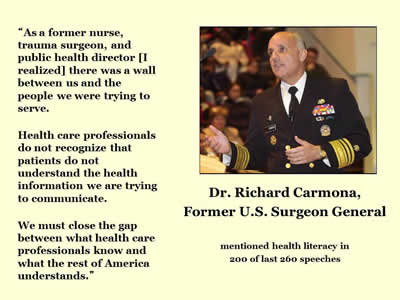
"Equally a sometime nurse, trauma surgeon, and public health director [I realized] in that location was a wall betwixt u.s.a. and the people we were trying to serve. Health care professionals do not recognize that patients practise not understand the health data we are trying to communicate. Nosotros must close the gap between what wellness care professionals know and what the remainder of America understands."
Image: Photograph of Dr. Carmona with the text "mentioned health literacy in 200 of terminal 260 speeches" below.
Speaker's Notes:
Dr. Richard Carmona who was recently the Us Surgeon General adopted health literacy is one of his primary interests. In one speech communication he said "As a sometime nurse, trauma surgeon, and public health director, I realize in that location is a wall between us and the people we were trying to serve. Healthcare professionals do not recognize that patients exercise not understand the wellness data we are trying to communicate. We must close the gap between what healthcare professionals know and what the residual of America understands."
This quote sums up the charge to us every bit a primary care practice.
Slide 7. U.S. high school dropout charge per unit is 30%

Image: Road painters have written the word "SHCOOL" on the road. Below the prototype it says U.Southward. high school dropout rate is xxx%. Source is EPE Enquiry Center (2008). "Cities in Crunch".
Speaker's Notes:
This side by side slide has a very funny moving-picture show. Only the statistic underneath is concerning. In the United states 30% of our youth practise not graduate from high schoolhouse. Another thing that is even more apropos is that this number has not changed in xxx years. We take a lot of people who, for a diversity of dissimilar reasons, are not receiving the bones education the need to function well in a healthcare system.
Slide 8. Red Flags for Depression Literacy

- Frequently missed appointments.
- Incomplete registration forms.
- Non-compliance with medication.
- Unable to proper noun medications, explain purpose or dosing.
- Identifies pills by looking at them, not reading characterization.
- Unable to give coherent, sequential history.
- Ask fewer questions.
- Lack of follow-through on tests or referrals.
Epitome: A red flag.
Speaker's Notes:
So what are some of the warning signs that our patients may have low literacy. None of these are perfect indicators. Just when nosotros detect these in our patients, we should consider that low wellness literacy could be a bulwark. Let's discuss some of the items listed:
Frequently missing appointments It could be that the patient is unable to read the appointment slip or it may likewise mean that they don't accept an organizational system at home to call back appointment.
Incomplete registration forms may result because the form is overly complicated for that private patient.
Noncompliance with medication therapy. Many clinicians become very frustrated with patients who don't take medications correctly. But this may effect not because the patient does non want to do information technology right, but considering the patient does not take a clear understanding of the importance of the medication and that they need to go along taking their medications after the pill bottles are empty. Some people don't sympathise how to become medications refilled.
Unable to name medications or explicate the purpose or dosing of the medications.
Identifying the pill past looking at them and not by reading the characterization. A lot of people do this even when they can read well. But if yous can't read well, you don't take any other choice.
Unable to give coherent sequential history. This may exist a more specific sign that this person has had trouble in schoolhouse because ane of the things that school teaches usa is how to organize our thoughts and presentation.
Asking fewer questions. If the patient is one who does not inquire any questions, he/she may exist trying to hide that he/she does not understand.
Lack of follow-through on tests or referrals. A common frustration for us as clinicians, just what nosotros don't consider is that the patient may be struggling with understanding how to brand the follow up occur.
Slide 9. Mismatched Communication
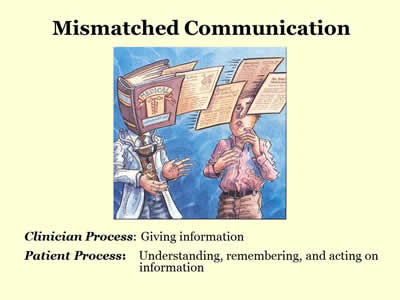
Clinician Process: Giving information.
Patient Procedure: Understanding, remembering, and acting on information.
Image: Film shows a doctor giving medical information to a patient, who is looking perplexed.
Speaker's Notes:
This slide expresses a common scenario. Every bit clinicians we are constantly providing information to patients. The patient must understand, remember, and deed on that information. Many of our patients can feel like nosotros're just reciting a textbook or procedure manual.
Slide 10. Our Expectations of Patients are Increasing...

- Prevention (eating, exercise, sunscreen, dental),
- Immunization,
- Self Assessment of Health Condition:
- Peak flow meter.
- Glucose testing.
- Cocky-treatment:
- Insulin adjustments.
- Health Care Apply:
- When to go to dispensary/ER.
- Referrals and followup.
- Insurance/Medicare.
Speaker's Notes:
Another part of the consequence is that nosotros wait more than and more of our patients. We desire them to swallow right , exercise, employ sunscreen, and have regular dental exams. Nosotros accept many more immunizations to give. We ask them to assess their health status using glucose testing or a elevation flow meter. Nosotros asked them to accommodate their medicine, such as insulin. We expect them to know exactly when they should go to the clinic or the emergency room and follow up on all of the referrals we make. And of class we ever expect that they volition understand their insurance.
Slide 11. And the Process is Condign More Circuitous
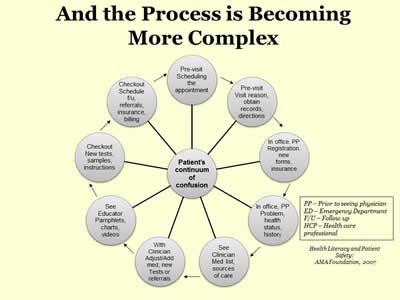
Prototype: A flowchart shows the Patient'southward Continuum of Defoliation. "Patient's Continuum of Confusion" are shown in the middle of a circle. Arrows prove the different processes that a patient could get confused about. The graphic is from the book Health Literacy and Patient Safety, AMA Foundation, 2007.
Speaker'south Notes:
When a patient comes into our function and has to follow through several steps. Some have called this the continuum of confusion.
Slide 12. Patient Safety: Medication Errors

"How would you accept this medicine?"
395 primary care patients in 3 States:
- 46% did not empathize instructions ≥ one labels.
- 38% with adequate literacy missed at least 1 label.
Source: Davis TC, et al. Register Inst Med 2006.
Image: Photograph of a medicine bottle and iv pill containers.
Speaker'southward Notes:
Let'south look at some interesting research that was washed. When researchers asked patients how would yous have this medicine and handed them a pill bottle, almost one-half did not empathise the instructions on a least i of the labels they looked at. And it is interesting to note that for patients with adequate literacy, 38% missed at least one characterization.
Slide xiii. "Show Me How Many Pills You Would Take in one Day"

Image: A pill bottle with a fictional md, fictional patient, and fictional medication with instructions to "Take 2 tablets by mouth twice daily".
Speaker's Notes:
These researchers went on to take patients evidence them how they take their medicines. So the first question was to have them read the bottle to testify that they can actually read it. Then they asked them to accept the pills out of the canteen and prove how many pills you would have each day and when you're going to accept them.
Slide 14. Rates of Correct Understanding vs. Demonstration "Take Two Tablets by Oral fissure Daily"

Image: A bar chart shows the following data:
| Patient Literacy Level | ||
|---|---|---|
| % Correct | Understanding | Demonstration |
| Low | 71 | 35 |
| Marginal | 84 | 63 |
| Adequate | 89 | 80 |
Source: Davis TC, et al. Annals Int Med 2006.
Speaker's Notes:
This slide shows some results from this study. Along the bottom (x-centrality) y'all have the patient literacy level. Patients were categorized as having low, marginal, or adequate literacy. The yellowish bars prove the per centum of patients in each literacy level who can read the instructions on the pill bottle correctly. The green bar shows the per centum of patients who actually took the right amount of pills out of the bottle when showing how they would take the medicine.
It is troubling to see how many patients would be taking this prescription incorrectly. Most of u.s. assume that, when nosotros write a prescription, the patient will be able to take it correctly.
Slide 15. Rates of Correct Understanding "Take Two Tablets by Mouth Daily" vs "Take one tablet in the morning and one at 5 pm"
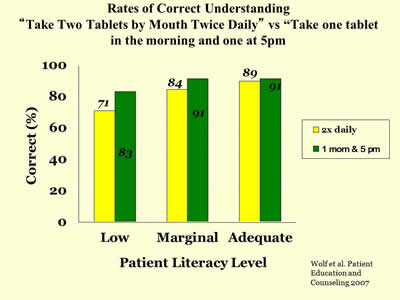
Image: A bar chart shows the post-obit data:
| Patient Literacy Level | ||
|---|---|---|
| % Correct | 2x daily | 1 forenoon & five pm |
| Depression | 71 | 83 |
| Marginal | 84 | 91 |
| Adequate | 89 | 91 |
Source: Wolf et al. Patient Educational activity and Counseling 2007.
Speaker's Notes:
This slide shows some results from this report. Forth the bottom (x-centrality) you lot accept the patient literacy level. Patients were categorized as having low, marginal or adequate literacy. The yellow bars show the pct of patients in each literacy level who correctly understood the label instructions "Take 2 tablets past mouth twice daily" on the pill bottle. The light-green bar shows the percentage of patients in each literacy level who correctly understood the label instructions. "Take one tablet in the morning time and i at 5pm.
This demonstrates that providing clear, specific instructions enhances understanding.
Slide sixteen. Lessons Learned From Patients
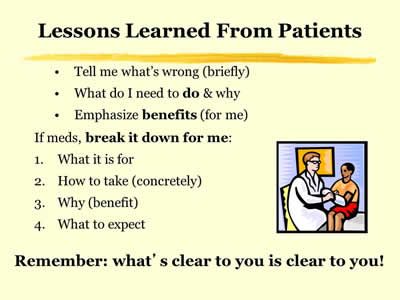
- Tell me what'southward incorrect (briefly)
- What do I need to do & why
- Emphasize benefits (for me)
If meds, suspension it downwards for me:
- What it is for
- How to accept (concretely)
- Why (benefit)
- What to expect
Remember: what's clear to you is clear to you!
Image: A doctor is shown disposed a patient with a bandaged arm.
Speaker's Notes:
What exercise we learn from patients? From interviewing hundreds of patients and performing many focus groups, experts have found that patients have some good ideas for usa. They want us to tell them what's wrong, just continue information technology cursory, so tell them what they need to do and why. And to emphasize the benefits for the patient.
For example, If information technology'due south about taking a medication, we should suspension information technology downwards:
What is the medication?
Exactly how do I take this medicine?
What is the benefit for me if I have this medicine?
And what tin I expect in terms of side effects and benefits?
Slide 17. Strategies to Improve Patient Understanding
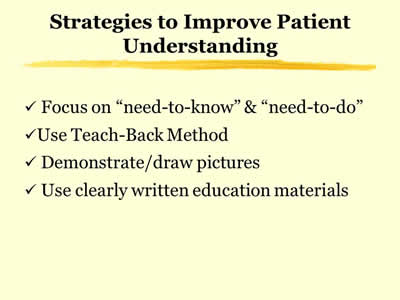
- Focus on "need-to-know" & "need-to-exercise".
- Use Teach-Dorsum Method.
- Demonstrate/draw pictures.
- Utilize clearly written education materials.
Speaker'due south Notes:
A few things that we can do when working with patients are:
Focus on the need to know and need to do. Patients say that nosotros often give them a lot of actress data. They want physical steps.
Used teach-dorsum method to confirm understanding—I will a talk about this in a minute.
Use pictures or demonstrate. Don't just talk about it.
And always use clearly written education materials that we know the patient tin understand.
Slide eighteen. Focus on "Demand-to-know" & "Need-to-do"
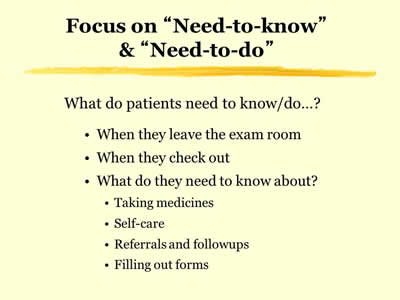
What do patients need to know/do...?
- When they leave the exam room.
- When they check out.
- What practice they need to know near?
- Taking medicines.
- Self-intendance.
- Referrals and followups.
- Filling out forms.
Speaker's Notes:
When focusing on what patients "need to know" and "need to do", it's helpful to call up nigh what the patient needs when they leave the exam room, when they check out, and what they need to do when they get abode. How practise they take their medicines, what cocky-care strategies tin can they use, what near any referrals or follow-upwardly items, what forms do they demand to make full out?
Slide xix. Teach-Dorsum Method
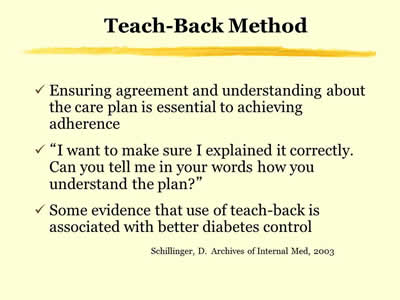
- Ensuring understanding and understanding about the intendance plan is essential to achieving adherence.
- I desire to brand certain I explained it correctly. Tin can you tell me in your words how you sympathize the plan?"
- Some evidence that utilise of teach-dorsum is associated with better diabetes control.
Schillinger, D. Archives of Internal Med, 2003.
Speaker's Notes:
Some other strategy is to enquire the patient to teach-dorsum the information we discussed. This is called the teach-back method. It is a way to ensure agreement and agreement well-nigh the intendance program, and is essential to achieving adherence. One way to practise this is after discussing a care strategy with the patient, you can say "I want to make sure I explained it correctly, can you tell me in your ain words how you understand the plan nosotros have made to control your blood sugar?"
There is some evidence to suggest that using the teach dorsum is associated with better diabetes control.
Slide 20. Teach-Back Improves Outcomes Diabetic Patients with Depression Literacy

Audio taped visits—74 patients, 38 physicians.
- Patients recalled 50% of new concepts.
- Physicians assessed agreement using teach-back 12% of time.
- Use of teach-back was associated with good glycemic control.
- Visits that assessed call back were non longer.
Schillinger, D. Athenaeum of Internal Med, 2003.
Speaker'due south Notes:
In another study researchers assessed whether or not physicians used the teach-back method during function visits and some interesting information was observed:
Patients recalled less than one-half of new concepts presented during the visit.
Physicians assess patient remember only 13% of the fourth dimension.
When physicians used the teach dorsum the patient was more probable to take HbA1c levels beneath the mean value.
Visits that assessed patient call up were not longer.
Slide 21. Teach-back
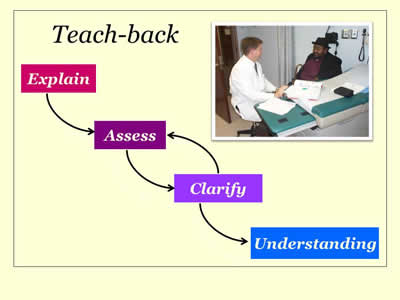
Images: Schematic showing the teach-back method. It is: Explain, Assess, Clarify, and Agreement. Photograph of a doctor speaking with a patient.
Speaker's Notes:
Here is a schematic of the teach dorsum method. The idea is to explain the self-direction process, and then appraise the person'due south knowledge past request them to teach it back to the clinician. The clinician can so analyze if the patient does not quite have it downward. This bike tin can be repeated until there is a shared agreement.
Slide 22. Confirm Patient Agreement
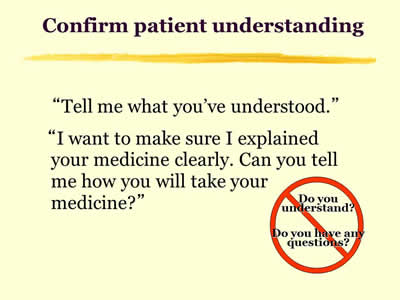
"Tell me what y'all understood."
"I want to make sure I explained your medicine conspicuously. Can yous tell me how you lot will take your medicine?"
Image: A circumvolve with a blood-red line through the questions "Do you understand? and "Do you have any questions?"
Speaker'due south Notes:
When you are confirming patient understanding, it'south best to avoid questions such as "Do you empathise?" or "Do you have any questions?" That strategy normally leads to the respond of "No".
Rather we want to say, "Tell me what you've understood nigh this medicine?" or "I desire to make certain I accept explained your medicine clearly, can you tell me how y'all think you will take this medicine?"
Slide 23. Patient Education: What Nosotros Know
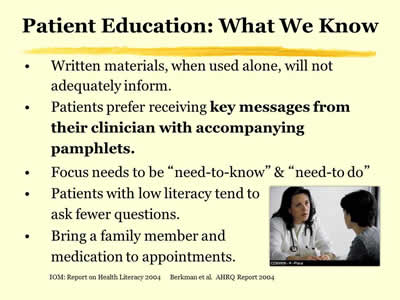
- Written materials, when used lone, will not adequately inform.
- Patients prefer receiving cardinal letters from their clinician with accompanying pamphlets.
- Focus needs to exist "demand-to-know" & "need-to practise"
- Patients with low literacy tend to ask fewer questions.
- Bring a family member and medication to appointments.
Source: IOM: Report on Health Literacy 2004. Berkman et al. AHRQ Study 2004.
Image: Photograph of a doctor speaking with a patient.
Speaker's Notes:
Beyond using the teach-back method, we need to consider how we organize patient education. Written materials, when used lone, will not adequately inform. Patients prefer receiving key letters from their physician with accompanying pamphlets. It is improve to think of a pamphlet equally a facilitator of a conversation rather than a replacement of a chat.
When we design our messages for patients, we should focus on the need to know and demand to exercise. Often times, those of usa in the medical field give a lot of extraneous data. For instance, pathophysiology rarely helps the patient. What patient's generally want is what they "demand to know" and "need to do".
It is important to call up that patients with low literacy tend to enquire fewer questions. Information technology is dependent upon the states, the staff, to aid patients identify what they need to hear again and to assess whether they empathize.
Lastly, information technology can exist very helpful to take a patient bring a family unit member or friend, AND their medications to any appointment. Having a family member present helps ensure that questions get asked and helps the patient to think what was discussed. Bringing their medicine bottles helps to facilitate a discussion with the doctor.
Slide 24. Visuals Improve Understanding/Recall
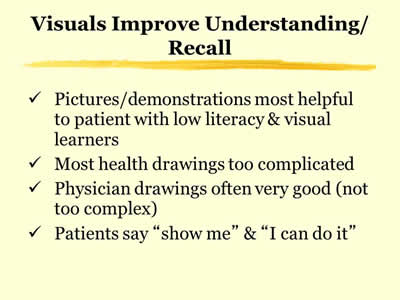
- Pictures/demonstrations nigh helpful to patient with low literacy & visual learners.
- Virtually health drawings too complicated.
- Physician drawings often very expert (not too complex).
- Patients say "show me"& "I tin can exercise it".
Speaker's Notes:
Using pictures can help patients think more. People with low literacy and visual learners tend to rely more on pictures
Most of the drawings nosotros utilize in health intendance are too complex and are hard to figure out. Rather, patients like the medico drawings because they are usually not very complex.
Information technology is also helpful to demonstrate how to exercise things. Rather than talking nearly it, really demonstrate what the patient needs to exercise.
Slide 25. seven Tips for Clinicians
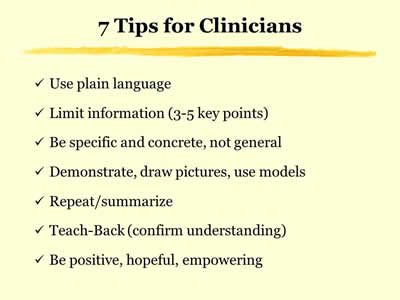
- Use evidently language.
- Limit information (iii-5 key points).
- Be specific and physical, not general.
- Demonstrate, depict pictures, use models.
- Repeat/summarize.
- Teach-Back (confirm agreement).
- Be positive, hopeful, empowering.
Speaker's Notes:
Hither are 7 tips for all of usa when working with our patients.
Use plain language. Call up near how yous would explain things to the cashier at the grocery shop.
Limit the key points to no more than 3 to five. Think about what you desire the patient to call up and focus on those.
Exist specific and concrete. Not full general. If action is involved, go through every detail.
Demonstrate actions, draw pictures. Utilise models if y'all have them.
Repeat and summarize the information. Well-nigh of united states don't recall when nosotros are told something once. Nosotros need to hear information technology a few times.
Use the teach dorsum method to confirm understanding and to assistance patients movement the information into long-term memory.
Lastly, be positive, hopeful and empowering. Our patients are relying upon us to become through this complicated health intendance system. Let'southward go along a positive attitude and help them all we tin can.
Slide 26. Use Patently Linguistic communication
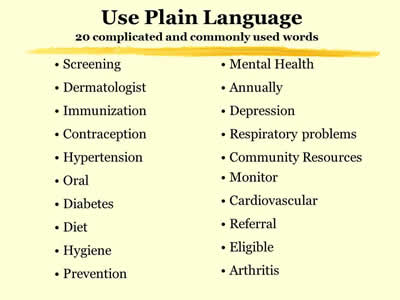
20 complicated and commonly used words
- Screening.
- Dermatologist.
- Immunization.
- Contraception.
- Hypertension.
- Oral.
- Diabetes.
- Diet.
- Hygiene.
- Prevention.
- Mental Wellness.
- Annually.
- Depression.
- Respiratory problems.
- Customs Resources.
- Monitor.
- Cardiovascular.
- Referral.
- Eligible.
- Arthritis.
Speaker'south Notes:
Here is a list of words we often apply that are considered complicated. Can you think of other words we could use in their place?
Slide 27. Examples of Manifestly Language
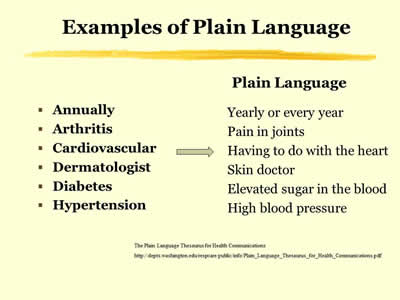
Patently Linguistic communication
- Annually → Yearly or every year.
- Arthritis → Pain in joints.
- Cardiovascular → Having to do with the heart.
- Dermatologist → Pare doc.
- Diabetes → Elevated carbohydrate in the claret.
- Hypertension → High blood force per unit area.
Source: The Plain Linguistic communication Thesaurus for Health Communications (http://depts.washington.edu/respcare/public/info/Plain_Language_Thesaurus_for_Health_Communications.pdf)
Speaker's Notes:
Here are some examples.
Slide 28. Is Your Clinic/Site Patient Centered?
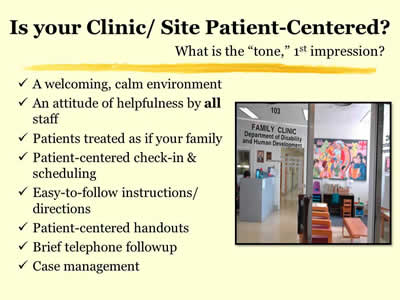
What is the "tone," 1st impression?
- A welcoming, calm environment.
- An mental attitude of helpfulness by all staff.
- Patients treated as if your family.
- Patient-centered cheque-in & scheduling.
- Easy-to-follow instructions/ directions.
- Patient-centered handouts.
- Brief telephone followup.
- Case management.
Image: Photograph of a Family Clinic reception area.
Speaker's Notes:
As we reflect on how we provide care, let'due south likewise recall about the impressions nosotros requite patients. Are we providing patient-centered care. Have we created a welcoming, calm surround?
Do we see an attitude of helpfulness from all staff including patient-friendly appointment scheduling, patient-friendly check-in procedures, and easy to follow instructions for referrals and tests. Accept we incorporated patient centered handouts? Are nosotros following-up with our patients over the phone? Do we provide any type of case-management for patients who need extra help?
Slide 29. Discussion Questions
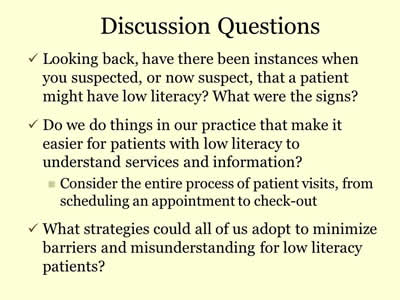
- Looking dorsum, have in that location been instances when you suspected, or now suspect, that a patient might have depression literacy? What were the signs?
- Do we do things in our exercise that make information technology easier for patients with low literacy to sympathise services and information?
- Consider the entire process of patient visits, from scheduling an appointment to check-out.
- What strategies could all of united states of america adopt to minimize barriers and misunderstanding for low literacy patients?
Speaker's Notes:
Hither are some discussion questions to help united states of america talk nigh the upshot of health literacy for our practise:
Looking back, have there been instances when you suspected, or now suspect, that a patient might have depression literacy? What were the signs?
Do nosotros practice things in our practice that make information technology difficult for patients with low literacy to empathise services and data?
Consider the entire process of patient visits, from scheduling an appointment through cheque-out.
What strategies could all of us prefer to minimize barriers and misunderstanding for low literacy patients?
Slide 30. Acknowledgments
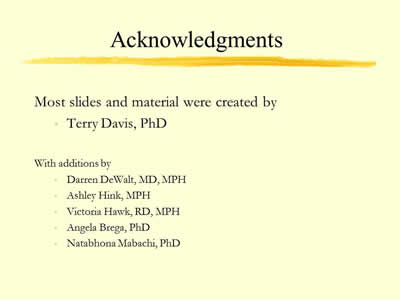
Near slides and cloth were created past:
- Terry Davis, PhD.
With additions by:
- Darren DeWalt, MD, MPH.
- Ashley Hink, MPH.
- Victoria Hawk, RD, MPH.
- Angela Brega, PhD.
- Natabhona Mabachi, PhD.
Source: https://www.ahrq.gov/health-literacy/improve/precautions/1stedition/tool3.html
0 Response to "How Do You Teach Patients That Can Not Read or Write"
Post a Comment